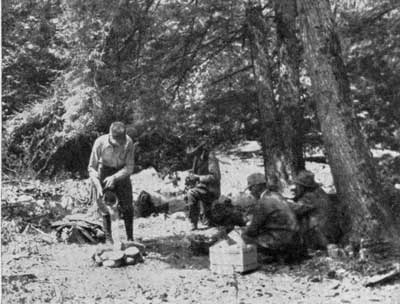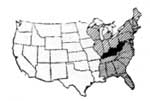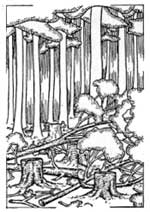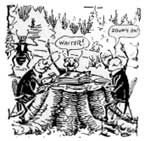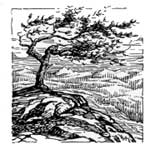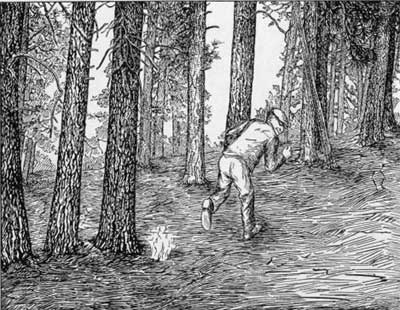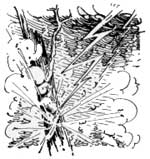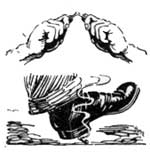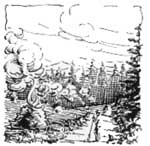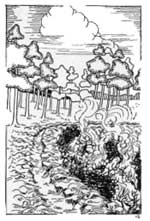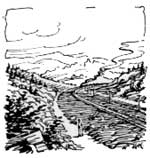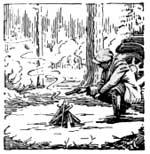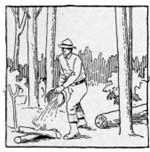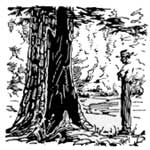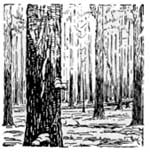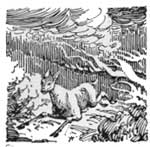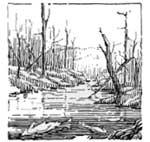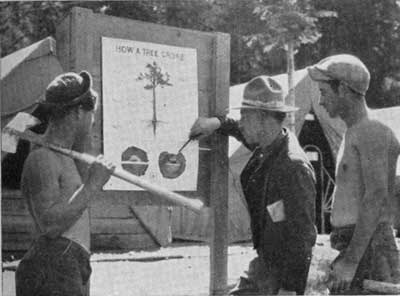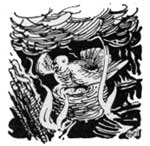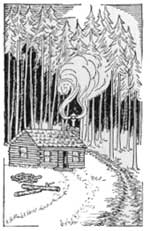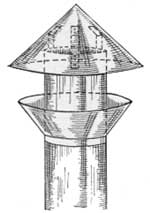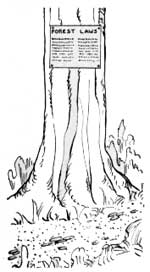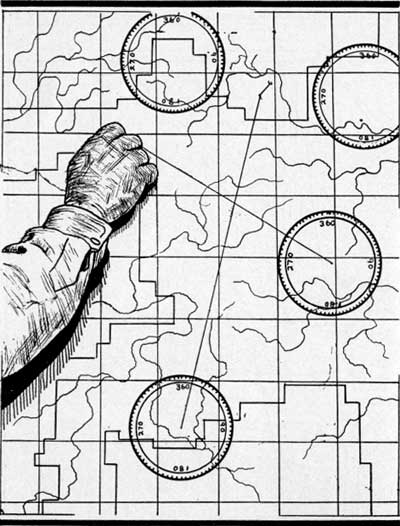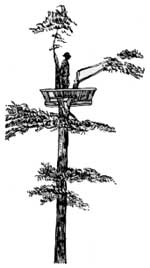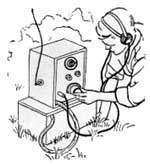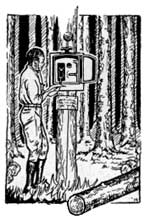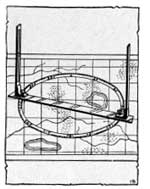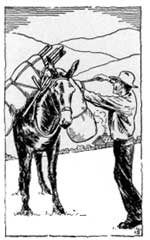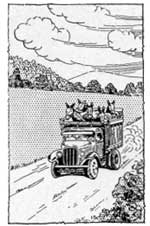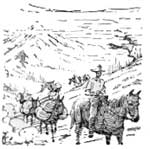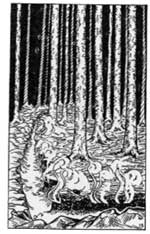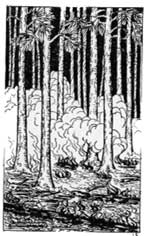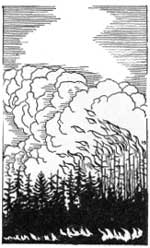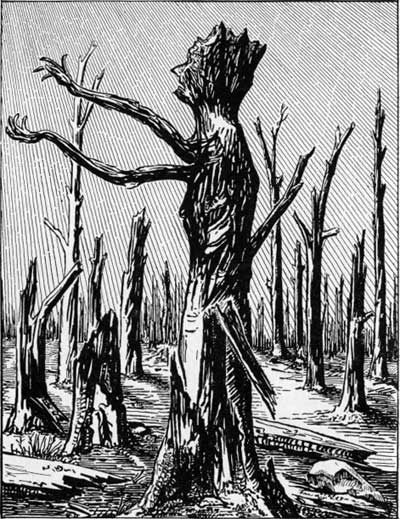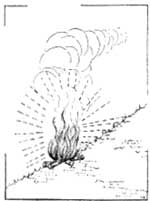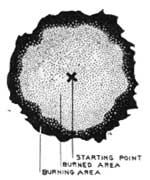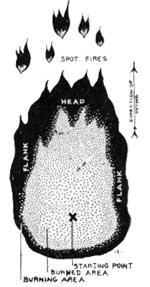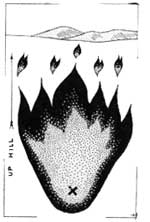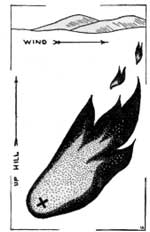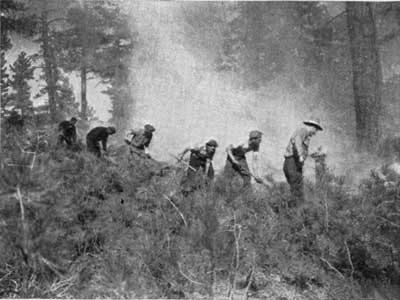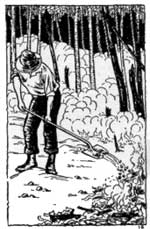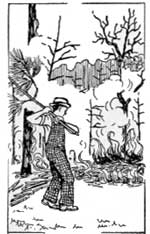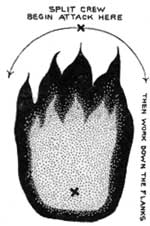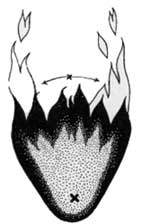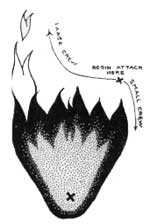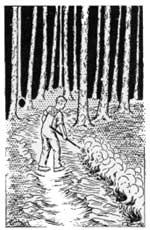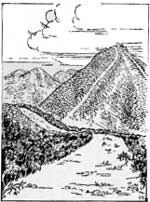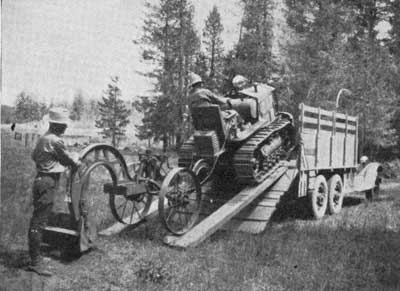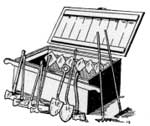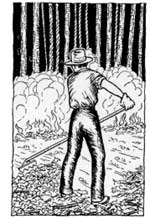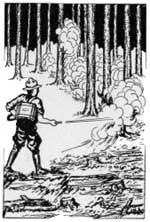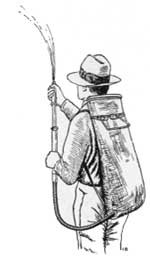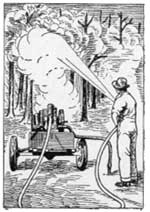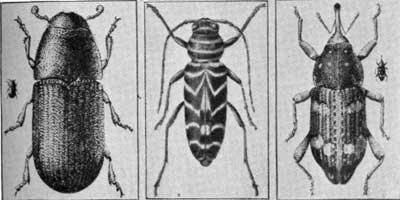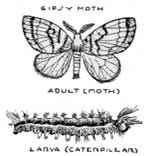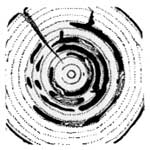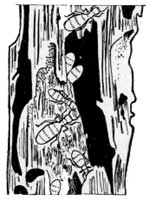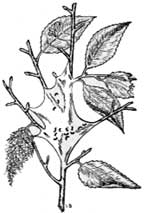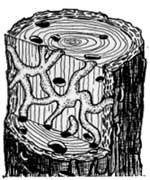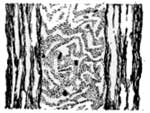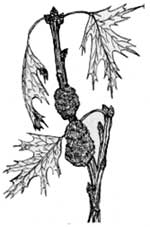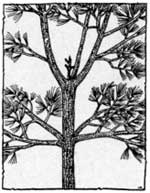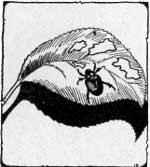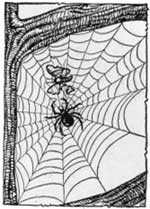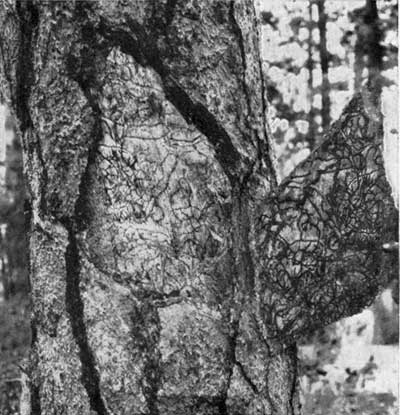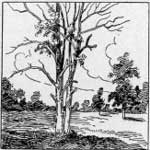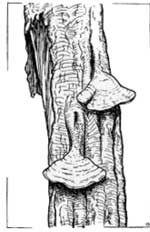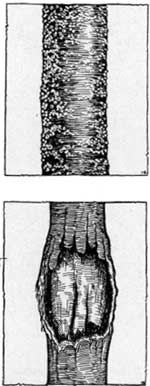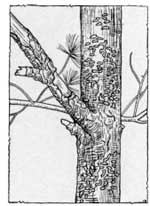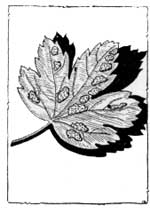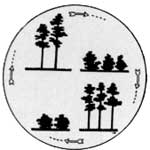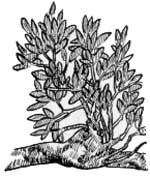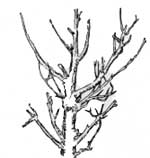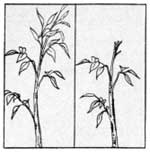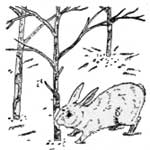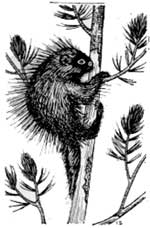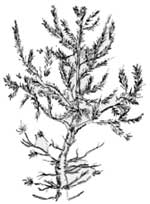|
CCC Forestry
|

|
Chapter IV
FOREST PROTECTION
|
LIKE all living things, the forest is constantly attacked by many enemies. Probably the greatest enemy of the forest has been man.
|
|||||||||||||||||||||||||||||||||||||||||||
|
Forest fires from natural causes are uncommon except in a few regions of the country. Man-made or man-caused fires are common in most sections. During the period 1926-30 an average of 156,000 fires occurred and more than 41-1/2 million acres burned over each year in the United States. The greatest number of fires occurred and the largest acreage was burned in the South. The least destruction by fire occurred in the southern Rocky Mountain region. Average Annual Burn (1926-30) on National Forest, State, and Private Forest Lands
Wasteful lumbering methods and excessive cutting have reduced the forest area. Man, instead of cutting only the mature trees, has cut all that might yield a merchantable log, and has left a field of inflammable brush and slash in which fires might gain the start necessary to consume the few remaining trees.
Normal attacks of insects and diseases seldom completely destroy a forest area. These pests usually confine their damage to old, dying trees or to weakened and suppressed ones that are soon replaced by new growth. It is only when insect and disease attack becomes widespread or epidemic that great damage is evident. By changing natural forest conditions, man has made trees more susceptible to diseases and insects. Because of the nature of insect attacks it is difficult to compute the damage annually incurred through them. Estimates ranging from 100 to 150 million dollars have been placed as the annual cost of such attacks. Diseases may be at work for years before their damage becomes evident. Diseased trees which appear sound may be found on cutting to have but a shell of sapwood surrounding a punky, decayed core. Other diseases affecting leaves and branches may not kill trees, but may so retard their growth that an undeniable loss is incurred. Over a large area the sum total of these losses may present a major problem in protection. Epidemic attack, such as that which killed the chestnut and that which now threatens the American elm, brings out new problems in wood use and demands changes in forest management policies. Damage by animals in the virgin forest is usually overcome by tree growth, but man has introduced numerous domestic grazing animals into the forest which often destroy trees faster than natural means can replace them, and has caused the concentration of wild animals on relatively small feeding areas. Uncontrolled grazing of goats, sheep, cattle, and hogs destroys reproduction, and removes protective cover from the forest floor. This allows the forces of erosion to carry away valuable forest soil, and prevents the regeneration of the forest after cutting. In some regions deer and other wildlife, especially when concentrated on small areas, produce much the same effect as domesticated animals. Porcupines and rabbits kill thousands of trees by girdling them in search of the succulent inner bark; beavers often flood vast areas of rich bottomlands, ultimately killing all forest vegetation. Frosts, wind, sun, and lightning add to the list of agencies that may at times destroy timber. These are forces over which man has no control. In planting trees, however, he should use only hardy species on adverse sites, and less hardy species on protected areas. Cuttings may be made so that remaining trees are left in clumps or groups in which wind damage will not be likely to occur. Since man has added to and intensified the enemies of the forest, he must now add to and intensify forest protection if he wishes to profit by the perpetuation of forest values and influences. |
Man Causes Fires.
Man Concentrates Destructive Animals. See Ch. XI, pp. 204, 213.
Reproduction, p. 99. |
||||||||||||||||||||||||||||||||||||||||||
|
|
|||||||||||||||||||||||||||||||||||||||||||
|
CAUSES Lightning: With the exception of lightning fires, all forest fires are man-made or man-caused. Although lightning fires are common in the Rocky Mountain and Pacific coast regions, they account for less than 10 percent of the total forest fires in the United States. In the East, lightning storms are usually accompanied by rain; and in the West where "dry storms" occur, extra personnel is employed during storm periods and hazardous seasons so that fires are usually detected when small. There is no way to prevent lightning fires, but they can be suppressed in their early stages if sufficient vigilance is maintained and prompt action is taken. Smoking: The greatest cause of forest fires is careless smoking. Matches, cigarette stubs, cigar butts, and pipe heels are responsible for more than 21 percent of forest fires. More than 9,000 fires in the United States each year are attributed to careless smokers. These fires can be prevented by the exercise of reasonable care. It is good practice never to smoke while walking or riding through the woods. If one must smoke, it is best to take "time out." The habit of breaking a match in two before discarding it should be acquired—not that half a match will not start fire, but a match must be out before the person of average sanity will attempt to break it. When disposing of smoking material, a spot should be cleared in the turf and the stub, butt, or pipe heel should be ground under foot into the mineral soil. Automobiles should be equipped with ash receivers; the highway should never be used as a public ashtray. Disregard of such inexpensive precautions, requiring only a second or two of time, may cause the destruction of valuable forests. Incendiarism: The malicious setting of fires by "firebugs" is responsible for 17 percent of each year's fire total. Incendiaries start fires for many peculiar reasons. One of their chief objectives is to improve grazing conditions. It has been found, however, that burning kills the better grasses and forage plants along with the weeds; burned stubble causes "sore mouth" in cattle and sheep; and that fire increases the growth of briars and introduces inferior brush. Woods are often burned to kill off beetles that attack farm crops, but surprisingly few farm pests live in the woods. Birds that help to control farm pests nest in the woods and fire destroys them and their young. This type of incendiarism can be stopped by educating the offenders. Fires started because of spite are sometimes most easily reduced through rigid law enforcement. In many instances the personality of the forest officer and his ability to make friends and to organize fire protective units are important factors in preventing incendiary fires.
Debris burning: The burning of brush and debris is a seasonal occurrence at farms and rural homes. More than 12 percent of the forest fires are started in this manner. Fires to remove weeds from farm areas or to consume trash are necessary, but care should be taken to see that they do not spread. The first step in burning fields, debris, or brush is to contact the local ranger or fire warden to secure his permission and suggestions as to the date and time of day to burn. Choose a quiet day with no wind, make brush piles small, clear a space to mineral soil around each pile or clear a wide line around the field to be burned. Do not start fires until after 4 o'clock in the afternoon (ordinarily fires do not spread rapidly after the sunsets), and be sure to have plenty of water, tools, and men handy in case of an emergency. The fire should not be left unattended until it has burned down and has been extinguished with water.
Railroads: Through lack of spark arresters, inadequately maintained rights-of-way, or carelessness of workmen, railroads cause more than 9 percent of the annual forest fires. Many States have laws specifying the precautions that must be practiced by railroad companies, and some railroads hire foresters to aid in fire prevention. State laws hold railroad companies financially responsible for all damage resulting from fires started by them. The use of oil and electricity for power will help to reduce the number of railroad-caused fires; cleared strips along rights-of-way are becoming more prevalent. Recreationists: Campers, hikers, picnickers, and others who use the woods for sport and recreation, and who should realize the need for fire prevention, cause almost 8 percent of the forest fires. Carelessness with campfires is the chief fault. Campfires should be built in stone fireplaces or in cleared areas if such are provided. It is sometimes necessary to make a fire where there are no campground improvements. In such cases a spot should be chosen near water or where there is an abundance of loose mineral earth. Never build a fire near a stump, log, or tree. A space should be cleared of all leaves and sticks and scraped down to the mineral soil; a wide area around the fire should also be cleared. Keep the fire small, and never leave it until it is out. Plenty of water should be poured on the sticks. If water is not available the fire should be permitted to burn out and should then be covered with loose earth free from all leaves and sticks. Other causes: In addition to these common causes of forest fires, lumbering accounts for almost 4 percent, about 9 percent are of miscellaneous origin, and for almost 10 percent the causes are unknown. It is apparent, therefore, that less than 10 percent of the forest fires are caused by lightning and that the remaining 90 percent are man-caused and are largely the result of carelessness or indifference. |
Prompt Action Necessary. A Good Rule for Smokers.
Have You an Ashtray in Your Car? Fire Bugs.
Getting Even With the Warden.
Slash should be piled, and burned in wet weather.
The Result of Human Carelessness. | ||||||||||||||||||||||||||||||||||||||||||
|
EFFECTS OF FOREST FIRES "Everybody Loses When Timber Burns" is a slogan we have seen blazoned on posters, blotters, letterheads, and pamphlets. Just how does everybody lose when timber burns? In the first place, we are all timber users. The average American citizen uses 130 board feet of wood and over 60 pounds of newsprint each year. This is in addition to the wood used for fuel, posts, poles, and ties. Timber destruction by fire results in higher prices for wood and wood products. Landowners cannot afford to pay taxes on charred stumps, so the tax burden bears increasingly heavy on those who can pay. Thus forest fires raise taxes and the manufacturer or producer whose taxes have been raised must raise the price of his commodity to pay the tax. Everybody loses! The losses listed are not the only ones. Quite often human lives and homes are lost in forest fires, and occasionally whole communities and industries are wiped out. When the forest is not burned completely it may seem that only underbrush has been removed. But the trees themselves are damaged or made susceptible to damage. Fire, if it does not kill trees outright, retards their growth and reduces yields, produces scars through which insects may enter to eat out and destroy valuable wood or through which diseases may attack and cause decay. It is not unusual for a forest to be rendered worthless by disease and insect attack some years after a burn that "does no damage." Seed and seedlings are destroyed, and it may be many years before a new generation will spring up to take the place of the old trees which are dying because of fire damage. Leaf litter and humus are consumed by the heat and flames, leaving a bare, sterile soil in which new trees cannot grow. The soil, unprotected by its former covering of spongy duff, erodes and washes away, filling streams, reservoirs, and channels with silt, reducing water power possibilities, and increasing flood damage. Wildlife is driven out of the forest or perishes in the flames. Young game especially is helpless in the heat and smoke of forest fire. Plants, upon which game thrives, are destroyed. The game that does escape to other areas may increase the population in those areas so that food becomes scarce, causing starvation and disease among the animals. Fish thrive in water that is slightly acid, and when the acid content of the water is neutralized with the leachings of wood ashes or the water becomes alkaline from the same cause fish die in great numbers. Fires also kill fish food. Insectivorous and song birds that nest in the woods near farms and feed upon the insects that attack farm crops, are killed defending nests and young against a relentless enemy. Shelter and food for game birds are destroyed as well as their nests. For recreational purposes the forest must have beauty and cool shade against the hot summer sun. These cannot be found on hillsides of blackened timber. Turn to the chapter on Forest Values (Ch. II) and after reading it try to imagine a country lacking in all or part of the forests' influences. Try to picture the effect of complete or partial forest destruction on homes, businesses, health, and public and private wealth. |
Killing Old Forests, Suppressing New Ones.
| ||||||||||||||||||||||||||||||||||||||||||
|
There are three major ways in which forest fires can be prevented: (a) Education of the public, stressing careful observance of precautions and stimulating an interest in forest preservation. (b) Removal of hazards so that the danger from disregard of precautions is lessened. (c) Legislation to enforce precautionary measures and hazard removal. Education of the public is probably the greatest means of fire prevention. Thoughtlessness and carelessness have been responsible for most of the country's forest fires. When wood owners and wood users realize the seriousness of forest fires and have safety measures brought to their attention, through speeches, newspapers, books, displays, radio programs, and other mediums so that care with fire and fire-causing agencies becomes second nature, fires will be less frequent. Hazard removal is closely tied to education. People who understand the causes of forest fires and the means of preventing them will do their part in helping to reduce man-made hazards. Roadside and right-of-way clean-up are two of the most necessary operations in hazard removal. Slash from logging operations should be either piled and burned or lopped and scattered (cut up into small pieces so that it lies close to the ground and decays rapidly). Spark arresters on trains, logging engines, and cabin chimneys prevent large sparks from firing the woods. In parks, camping grounds, and recreational areas, the camp fire hazard may be reduced by constructing special fireplaces for cooking, and by clearing a fire lane around the area. Cabins, homes, and industrial plants in or near the woods should have a cleared line surrounding them; this line will protect the property from woods fires and keep property fires from spreading into the woods.
Legislation is used as a last resort to enforce precautionary measures and hazard removal. If people can be educated to prevent fire there is no need for rigid laws to obtain the same end. In some cases it is necessary, however, to establish and enforce laws relative to brush disposal, hazard removal, campfires, and smoking. In national forests slash disposal is required on all lumber operations, and some States enforce such regulations in private logging areas as well. In most States firing the woods maliciously for any purpose is an offense punishable by law, and anyone allowing fires to spread to the forest through carelessness or disregard of precautions must pay damage and extinction costs. Often during dry seasons the forest will be closed to visitors or smoking will be prohibited. Although law enforcement is the only practical means applicable to certain classes of people, it should be used only when voluntary cooperation cannot be obtained. |
Education for Prevention.
| ||||||||||||||||||||||||||||||||||||||||||
|
In spite of present prevention efforts, the United States has more than 44,000 fires each year on protected lands. On unprotected lands the total is more than twice as much. The fact that protected land is equipped with fire-detection forces accounts for the large number of fires reported. Usually the fires are caught when they are small. Only the larger fires are reported on unprotected land. Detection: One of the most important phases of fire control is detection. Fire cannot be fought until it has been discovered. If too much time elapses between the start of the fire and the time the fire fighters arrive the blaze may have spread over a large area, making it impossible to control it promptly. Almost any fire in its early stage can be extinguished by one man. The job of the detection force is to locate the fire while it is still a one-man job, although this is seldom accomplished. An efficient detection force, can, however, discover a fire shortly after it starts and while it is still small. During fire seasons the detection organization is keyed to its utmost vigilance. Danger periods are determined by use of scientific instruments which measure wind velocity, temperature, and amount of moisture in the air, soil, and forest litter. Modern weather indicators differ greatly from the practical home-made devices of the old-timers. A fiddle string stretched between two posts would sag in dry weather and the old-time guard would look for "fire trouble." Or the rangers' corns would become troublesome when there was dampness in the air. Wind velocity was indicated by the size of tree branches set swaying. Today, towermen and rangers are advised of "fire weather" by reports from forest headquarters and by daily weather maps. Fire weather forecasts are sent out sufficiently in advance of bad conditions that extra personnel may be available, and extra precautions taken. Primary lookouts are established on peaks and highlands where commanding views of the surrounding territories may be had. These lookouts are usually permanent steel or wooden towers, manned by trained lookout men. In extremely bad weather or when visibility is hindered by haze, secondary lookouts are maintained in trees, or other elevations, and patrolmen in cars or on horseback keep a close watch on particularly dangerous areas. In many regions guards are stationed, during particularly bad seasons, at points such as road intersections or where communication facilities are handy, so that they may not only detect fires and report them but may actually go to the fire and aid in leading the attack. Many lookouts in hazardous sections are manned by two observers, one of whom acts as "smoke chaser" to tackle small fires occurring near the lookout, or to aid in leading crews to the fire. In the best protective units, prearrangements are made to have residents, bus drivers, track walkers, power-line patrolmen, train crews, mail carriers, passenger and mail plane pilots, and all cooperative agencies watch for and report fires. The location of the fire is the first step in control. Then the fire must be reported to the fire-fighting crews. Thus systems of communication must be established consisting of telephones, radio, roads, and trails. All permanent lookout stations are equipped with telephone, radio, or both. Cars outfitted with short-wave, transmitting and receiving radio sets are used where practicable, but the use of portable radio sets is still in its infancy. Portable field phones that can be attached any place on the line are standard equipment in most regions. A typical situation: To show how a fire-control force operates it may be well to follow one through its operations from detection to arrival at the fire: The towerman on Oak Knob has received his daily weather report from the district headquarters, and the weather conditions are those under which fires thrive. A light breeze has been drying the woods for 3 days. It may be weeks before the next rain. Tearing a sheet of paper from his notebook, he drops it from the tower window. It flutters slowly toward the ground, but before it drops 10 feet it is caught by the wind, and is borne far away as he watches it through his binoculars—a handful of burning leaves might travel just as far. The leaves on the ground are swirling in little eddies around the tower base. To make certain that the telephone is working, he makes scheduled test calls at given intervals to the ranger, the guards, or a few residents on whom he may have to depend for fire-fighting aid in case of an emergency. The towerman has a mental picture of the surrounding country; any wisp of smoke or hazy condition on the landscape will be evident to him. Just before noon he notices a thin curl of smoke rising in the distance; it ascends lazily, reaching a considerable height before it is blown into a hazy cloud. Smoke rises that way when the fire is in a protected spot away from the wind. With the aid of his detection instruments, the towerman finds the direction to the fire. In each tower there is a large map of the area visible to the observer. The center of the map is marked with a pivot representing the tower, and degrees (360°) are marked on a circle drawn from the same center point. Using an instrument known as an alidade he sights across the pivot to the fire. The alidade is a horizontal bar with an upright post at each end. Some fire-finding instruments are constructed with sights like a telescope. Sighting across the pivot, he reads the compass direction on the circle.
This information is telephoned to the ranger station along with the towerman's judgment of the distance to, and the size of the fire. If no other observer reports the fire, the ranger must proceed on this knowledge. Most protective units are laid out so that two towers view the same areas. The towerman on Piney Summit has also seen the smoke and he too calls the ranger station. Now the ranger has two readings from different points. On a large control map, on which both towers are marked, he stretches two strings—one from the map location of each tower—in the directions reported by the towermen. The point on the map where the two strings cross indicates the location of the blaze. From the map, the ranger picks out the best route to the fire, and locates the homes of fire wardens and a few residents. By telephone he instructs the wardens or the local inhabitants where to report. One man, a "smoke chaser" is sent from headquarters with a car or truck containing enough tools for six men. He may reach the fire in time to get it under control before the crew arrives, or to make plans for the attack if the blaze is too large for one man to handle.
The warden calls his crew together hastily but not haphazardly. His men have been ready for this emergency. The fire truck is always loaded with tools and ready for use; and, when the crew arrives from their farms, shops, stores, and other duties, away they go. Additional tools may be secured, if necessary, from the tool caches or boxes that have been placed at strategic points throughout the forest. Emergency rations of nonperishable foods have been taken along with the men and tools; local stores have lists of other foods available so that the warden or smoke chaser may order them if the fire demands additional men and supplies. That is the way a protective unit operates when it is equipped with adequate towers and telephones. Some areas, however, are not so well equipped. In these, foot or horse patrols may be used. Slower methods of communication are practiced. Messengers may carry the news of fires, and crews may be organized by more crude methods. In such units, fires grow while preparations are being made to fight them. Better towers, telephone systems, and trails are needed. Although recent forest developments have brought good roads and trails to formerly inaccessible areas, there are still some places where it is necessary to go on foot and to take equipment to fires by pack animals. In such cases the men and animals are transported as far as possible in trucks. Large fires, requiring large numbers of men over periods of days or weeks, present difficult problems in feeding and transporting the fire-fighting personnel. The mule becomes as important to the advance of the fire army as it is to a military operation, being an invaluable asset when it comes to packing in supplies over precipitous trails. Crew training: Each fire is a problem in itself; no two are alike. Topography, types of cover, wind, humidity, and available men differ with every occasion. At best, only broad, general plans may be made in advance of a fire season. Plans are subject to change on the job, the judgment of the fire boss or warden in charge being the governing factor in every case. Hence, fire wardens are trained in fire-fighting and usually have an intimate knowledge of the forest and local topography. Schools for wardens and guards are held each year before fire season begins. At these schools (camps in the forest) the men are taught all the fundamentals of fire control and the uses of new tools and instruments. Upon returning from the training camp, the wardens in turn instruct fire crews in the same knowledge. |
Science Aids Protection.
Emergency Guards.
Where There's Smoke There's Fire.
Headquarters Is Advised.
Schools for Wardens and Guards. | ||||||||||||||||||||||||||||||||||||||||||
|
KINDS OF FIRES Three types of forest fires are recognized by foresters: (1) Ground fires, (2) surface fires, (3) crown fires. A fourth kind may occur in the forest when a tree is fired by lightning and is extinguished before it spreads to the forest. Such fires are known as "tree fires." Ground fires: Fires which burn in the thick duff and leaf mold and leaves on the ground or in peat lands are known as ground fires. Often they burn along under the surface, giving off little or no smoke. For this reason they are difficult to locate until they burst out in the dry leaves on top. They may burn for days or weeks unnoticed, killing roots and underground organisms essential to tree growth, and on a dry day come to the surface to start a large surface fire. These fires often occur where campfires have been built on thick mats of duff. It is not uncommon to find a foot or more of duff in dense pine, hemlock, or spruce stands, as coniferous needles decay very slowly, particularly in the North. Often when a forest fire is thought to be out ground fires will smolder for weeks. Trenching of fire lines down to mineral soil is necessary to overcome outbreaks. Surface fires spread over the ground, consuming dry leaves, sticks, low brush, and small trees. Small reproduction is killed, and although large standing timber is not burned up, the heat retards root growth, sours sap, and burns the bark from the bases of trees. Large, basal fire scars form a port of entry for insects and diseases when the protective bark has been burned away. In a few years the butt log becomes riddled with insect tunnels, and decay starts working upward to make the tree worthless. Crown fires are of two classes. The "running crown fire" spreads through the tops, leaping from tree to tree ahead of the slower-burning surface fire. As flaming branches drop to the ground, showers of sparks spray the leaf litter, advancing the destruction along the surface. The "dependent crown fire" travels with the surface fire when the condition of the overstory is such that it must be dried before ignition. Heat waves, rolling up, evaporate all leaf and twig moisture, and tongues of flame lick upward from the burning brush to transform the crowns into fiery torches. When the three types of fire sweep over a forest, an area of complete desolation remains, the ground fire penetrating deeper and deeper until only powdery ashes cover a baked mineral soil. The desolation is intensified when rains follow, washing the ashes into streams where their alkaline properties kill fish and make the water unfit for drinking, and erosion leaves a heap of rocks—sun-bleached and sterile—in place of a wooded hillside. |
When the Fires Combine, Destruction Is Complete. | ||||||||||||||||||||||||||||||||||||||||||
|
HOW FOREST FIRES BURN Leaf litter and wood burn when their temperatures become great enough to cause them to burst into flame. The temperature to which anything must be raised before it ignites depends upon the amount of moisture in it. Dry leaf litter will burst into flame at about 800° F. When leaf litter is moist or wet, a much hotter flame must be applied to start fire. The amount of moisture in leaf litter depends largely upon the amount of moisture in the air. Dry air absorbs moisture from the litter, and when the litter is drier than the air it absorbs moisture from the air. Warm air is capable of holding more moisture than cold air. At night when the air temperature is reduced, and the relative humidity of the air is high, moisture leaves the air in the form of dew. Forest fires, therefore, do not burn so rapidly at night when the dew is on the litter and the air is damp, as they do in the daytime when the moisture has been drawn from the leaves to the air. Fires are at their lowest ebb about 4 or 5 o'clock in the morning before the sun rises to warm the air. This fact is an important one to keep in mind when tempted to quit fighting during the night. A fire which cannot be controlled by a large force of men in the afternoon can often be completely subdued by a small crew during the night or just before dawn. Leaf litter is dried also by heat from the fire. Fires spread because the heat from one burning spot radiates, or reaches out, to surrounding material, drying the moisture and making burning easier. Hot air, being lighter than cold air, rises, and at the same time heat is radiated sideways. Upward movement, or updrafts, and sideward radiation cause fires to burn uphill faster than down, although they will burn fast enough in any direction, particularly if aided by the wind.
Fires often spread rapidly downhill. A flaming log will leave a steep hillside and come rolling downward, gathering speed as it goes, striking rocks and bouncing over them in a shower of sparks, scattering destruction, and finally coming to rest in the leaves accumulated at the foot of the hill, whence fire spreads over a level stretch or marches up the opposite hillside. The speed at which a fire travels is governed largely by air movements. A dry day with a breeze is more dangerous fire weather than a dry day with no breeze. The stronger and drier the wind the more rapid the fire movement. Winds are usually stronger in the afternoon and early evening than they are during the night and early morning. This, too, indicates that night and early morning attacks should be made by fire-fighting crews. The type of fuel also influences the rate at which forest fires spread. Dry leaves, grass, dense brush, and slash burn rapidly, and green material burns slowly unless aided by winds or steep slopes. Peat fires usually burn slowly but persistently. The fire: Fires usually assume a more or less definite shape depending upon the direction and velocity of the wind. On level land, fires spread with the wind, in the shape of a long egg. On slopes they assume a fan shape, widening toward the top of the hill. Rapidly spreading fires on steep slopes run uphill in a wedge, pointed toward the brow of the hill, but if wind is blowing across the slope, the wedge usually broadens toward the top in the direction away from the wind. In rugged country it should be remembered that fires burn fastest on the steepest slopes. A fire may become a two- or three-headed monster when it runs into a draw and separates to ascend the slopes. Specific names are applied to the parts of a fire. It spreads most rapidly at the head. On a slope the head is usually the up-hill side, but a strong wind may force the fire across the hill and the head becomes the side away from the wind. On level land it is the side that advances with the wind. Opposite the head, on the other side of the fire, is the rear—the down-hill side on a slope, or the direction from which the wind is blowing in level country. The two sides connecting the head and the rear are known as flanks. Fire spreads most rapidly at the head, less rapidly from the flanks, and least rapidly from the rear. This should be constantly in mind when the attack is planned. It should be remembered also that a sudden shift in wind direction may change the positions of these parts. A fire 5 miles long and 1 mile wide, advancing under a north wind, can be transformed into one with a head of 5 miles if the wind shifts eastward. The fire-fighting organization should be acquainted with the wind habits of the locality. Spot fires are small fires started by sparks and burning material carried ahead of the fire by the wind. These soon assume the characteristic shape of forest fires and increase in size, aiding in the main fire's advance. |
| ||||||||||||||||||||||||||||||||||||||||||
|
FIGHTING FIRE In fire fighting the problem may be summed up as "when, where, and how" to attack the blaze. The attack should start as soon as the men arrive (men should arrive just as quickly as humanly possible), and the movement of the fire becomes known. The men are fresh and in condition to work 24 hours or more if by so doing the fire can be stopped. Fires become no smaller during delays in attack; they grow, and the suppression job becomes correspondingly more difficult. After the first day, when the job appears to be a large one, the energies of the men should be conserved for the time when they will do the most good. The largest force should start work before daybreak when the fire is comparatively quiet. Not much can be gained, on a long fire, by working the men more than 10 or 12 hours a day. A good plan is to concentrate the force, from 4 a. m. until noon, on fire fighting and to spend the heat of the day in patrol. Advantage should be taken of any time when the fire weakens—a light rain or an increase in humidity. When the fire-fighting force is familiar with the locality in which it is fighting, night attack has many advantages over day work. The fire burns less rapidly at night, the wind is usually more quiet, and the air is cool and moist. Before attacking, the fire boss must have a clear picture of the situation. The Western Fire Fighters' Manual advises, "Never attack haphazardly! A little head work saves a great deal of back work!" If an obviously important point is found it should be attacked at once, and scouts should be detailed to "size up" the fire and to report other vital spots where a little attention now will save much work later. Advantage should be taken of natural fire breaks, and their weak points strengthened. Winds, or probable winds, topography, types of cover, and streams are important factors in determining where to attack. Spot fires beyond the line of attack should be given immediate attention. Method of attack depends upon the kinds of fire, winds, topography, vegetation, and the number and experience of the men. Ground fires are fought with shovels, mattocks, axes, and water. Usually these fires take no definite direction except on slopes where the tendency is to burn uphill. They may be fought along their outer edges by digging deep trenches down through the vegetable matter to the mineral soil. Starting at the outer rim the ground is then drenched with water, if it is available. Usually such fires occur in areas where water is readily accessible and portable power pumps may be employed. Sometimes two lines of trenches are necessary to make the fire line stronger. A fire breaking out a week or two later easily may jump a small trench. It is good practice to send at least one man back after a few days to search out any warm spots that remain and to do the necessary work on them. Surface fires often may be fought by direct attack either with tools, water, or machinery. Brush and snags along the line are removed, and the leaves and litter scraped away with rakes. Shovels may be used to clear a line down to mineral soil and to retard the fire by throwing earth, removed from the line, over the burning edge. In the West, particularly in open stands, trail-builders, and tractor or horse-drawn plows are used to make the fire line. Fallen logs are not permitted to lie close to the line. It is sometimes possible to use water in direct attack. In this method a line is cut with axes and brush hooks; water is applied to the burning leaves and litter. Small surface fires often may be beaten out with green branches, wet blankets or burlap bags, but fires checked this way usually require a great deal of patrolling. In most cases the point of attack is at the most dangerous point, the head. Often, however, on fast-moving fires, the attack is made on the flank to reduce the width of the fire front. Otherwise the head attack might not be able to extend a line fast enough to cut off the entire front. When attacking the head, the crew begins working directly in front of the advancing fire, and splits into two groups to work around it. Usually the first man in each group wields a brush hook or small ax to cut a trail. He is followed by more men with similar equipment who lop off brush and small trees, widening the trail. Then come a group, armed with rakes, scraping back all leaves and twigs or, if the duff is deep, shoveling it away from the line down to mineral soil. Men packing spray tanks on their backs spray the fire along the line's edges with streams of water, or shovelers scoop earth to beat down the flames. Patrolmen with water, shovels, and rakes keep a sharp eye on assigned sections of the trail and prevent the fire from breaking through. The trench on the down-hill side should be deep enough to catch rolling sticks and logs. Sometimes it is necessary to build barriers of logs which must constantly be watched to prevent downward spread. Severe surface fires in which the first two methods are not practical are fought with fire. Fire trails are run some distance before the oncoming fire and are built much wider. Snags inside the fire line and near enough to its edge to create hazard should be felled; but if this is not possible, litter should be raked away from their bases. The leaves and litter along the trail on the side toward the fire are ignited with torches or burning brands. Since all the fuel has been removed from the trail, the backfire can burn only toward the main fire. It creeps slowly, but clears a wide path faster than could be cleared with tools. When the two fires meet they burn out for lack of fuel, and the area cleared by the backfire is too great for sparks to jump effectively. The distance from the main fire to the start of the backfire depends upon the speed with which the head is advancing. Often it is necessary to burn off a large area, or to go over the brow of a hill so that a good start may be given to the backfire. The practice varies with locality and individual fires. Often too much width is allowed and timber is burned unnecessarily. In other cases, too little width is allowed and the fire jumps across the line. Experience, particularly local experience, is an invaluable asset in determining backfiring procedure. It is a job that should not be delegated to green men or poor supervision. Indiscriminate use of back fires may cause more damage than the original fire, and such use should be prohibited.
From the head attack the line extends in two directions along the flanks. As the flanks burn more slowly than the head, it is often unnecessary to backfire along them; the line is swung in closer to the fire and direct attack is made. Crown fires usually must be fought from a distance, the object being to bring the fire down to the surface where it can be fought more easily. Wide lanes are established. Roads across the path of the head are good starting places from which to backfire. Spot fires are frequent because of the height to which sparks ascend. It is necessary to have some crew members beyond the fire trail constantly to kill spot fires before they grow. Sometimes crown fires become ground fires when they reach the brow of a hill or cross a steep ridge. Dependent crown fires, or those which travel with or after the surface fire, may be stopped with intensified surface fire-fighting tactics. Wider fire lanes are made and more territory back fired than on ordinary surface fires. The necessity of cutting timber is minimized to snags and moss-laden trees near the fire line. In areas where tree crown fires or brush crown fires are common, wide fire lines are permanent forest improvements. They are constructed 50 feet or more in width and are cleared of all trees and inflammable material. In hardwood stands where crown fires are not so common usually only the underbrush and litter are removed from fire lanes. When the fire has been stopped there is much work yet to be done. The trail is patrolled all around the fire. Burning snags are cut down and extinguished. Although many of the men are called off as soon as the fire is controlled, a large number are kept at work patrolling and "mopping." This continues until the last spark is out, and all danger of a new break is removed. |
Spot Fires Speed Up the Advance.
No Job for a Green Man. Controlling Crown Fires.
"Mopping Up." | ||||||||||||||||||||||||||||||||||||||||||
|
FIRE-FIGHTING EQUIPMENT Fire in the woods demands much different apparatus than that used by city fire departments. In the better city organizations adequate water supplies are nearly always available, chemical pumps may be used, and it is possible to bring tools and equipment right to the door of a burning building. Few forest fires occur where there are accessible water supplies, and fewer forests are checker-boarded with roads, as are cities. Hence the standard apparatus for forest fires consists of shovels, rakes, axes, saws, mattocks, hoes, and brush hooks. Ordinarily forest fires are not put out in the sense that one puts out a city fire such as a burning house. Rather the fire is stopped and allowed to burn out. Axes are used to cut out small logs, brush, and small trees, burning snags, and those likely to burn. Dead, burning bark that might carry fire up into the crowns is cut away, and the ax is indispensable for camp use. Pole axes can be used with a greater degree of safety than can double-bitted axes, but experienced axmen prefer double-bitted axes, because one edge can be used for rough work and the other kept sharp for finer work. For removing humus and litter along the fire edge and for throwing earth on fires the shovel is of prime importance. It is often used to spread backfire, and is an effective beater for small fires that cross the line. Hazel hoes, grub hoes, and mattocks are employed in line construction to tear up humus, cut roots, scrape away litter, and for trenching. They are much more effective than the shovel for any of these jobs. A number of rakes have been developed for clearing the ground of leaves and litter. Some combine the features of the mattock and rake, having triangular teeth with sharp cutting edges, others are combination hoe and rake. When special rakes are not available, and for ordinary raking, the common, heavy, road rakes can be used quite effectively in clearing fire lines. Horses and mules have been used to advantage in building fire lines with plows. Instead of the slow, laborious task of grubbing trenches in advance of a raging head, the job may be accomplished much more quickly by animal power. In rocky country this is not so effective as it is in gravelly or sandy soil. Men follow the plow with rakes and shovels to touch up the rough places and to complete the line over rocky stretches. The tractor has stepped in to replace the horse and mule. Having proved itself effective as the wartime tank in surmounting natural obstacles, it is now adapted to forest warfare. Large tractors are often hitched to logs or huge rocks and, with very little trouble, gouge out wide lanes down to mineral soil. Smaller tractors and plows are easier to handle in the woods, however. For most fire control work a 2-ton machine with a wheel plow is best. It will dig a furrow 20 inches wide and from 8 to 10 inches deep. Logs up to 8 inches in diameter break under the pressure of the plow, and it is constructed so that it lifts automatically over solid rocks. Bulldozers or trail-builders are used to open up fire lanes, to push logs and good sized trees out of the path, and to scoop out turf and litter.
Often logs must be cut from across the line or dangerous snags must be felled with saws. When much timber must be cut to bring a crown fire to the ground the saw has no substitute, although dynamite has been used to blast down snags and to open wide lines in a hurry. A recently developed portable power drill has speeded up this work. "Shot holes" may be drilled faster than loading and firing them. Water, when it can be obtained, is very useful in extinguishing standing snags, logs, and burning stumps, and for line patrolling. Galvanized tanks or water-proofed sacks equipped with short hose and hand pumps will throw a stream of water effectively for 20 to 25 feet. Water is obtained from nearby streams or is carried on trucks to the fire. Refills are given along the line from larger tanks carried by horses, mules, or men. Portable gasoline pumps that can be carried by one man have recently come into use. When water is available in nearby sources these pumps, with long hose lengths, are capable of pouring powerful streams of water to stop fires, and are great aids in mopping up. In some sections of California and other States, trucks equipped with pumps like city fire engines are used to subdue fires along roads. The pumps can draw water from streams or ponds, or, if necessary, draw on the 50- to 600-gallon tanks that they carry with them. These trucks are further equipped to carry a crew of 20 men with tools and supplies. Many logging companies have pumps attached to donkey engines to attack fires near the operation, and some logging trains have been equipped with pumps and hose to fight fire along railroad lines. Michigan in the past 3 years has started to use portable well-drilling outfits to supply water for fires. The driller or "washer" consists of a tank of water and a portable pump which washes a casing pipe down to a depth of 30 feet or more. Three men working ahead of a fire can sink and operate a well in 8 minutes with this apparatus. With long lengths of hose the water from one well may be used to wash in another well along the line. Of course this system is not applicable to regions where the water table is deep or where the ground is rocky, but in sandy lowlands or bog country the portable well driller and pump have great possibilities. For backfiring and burning debris inside the fire line, the torch is much more effective than matches or fire brands. Gasoline and kerosene are used for fuel. Torches similar to blow torches are able to ignite the most obstinate fire-line edges with a very hot flame. For the men on the line canteens are great aids to fire-fighting, although they are not used in the attack. A swig of cold water freshens parched lips and hoarse throats and gives the tired fire-fighter new life. Among other personal equipment each man should carry an extra pair of socks, and a supply of matches, preferably in a waterproof container. Lanterns or flashlights are used for night work and night travel, and they are particularly useful at camp. Miners' lamps worn on hats and caps have proved helpful in night fighting. Miscellaneous equipment that should be included on all fires of long duration consists of sledges, wedges (for falling trees inside the fire lines), files, grinders, and whetstones (for sharpening tools). Medicine kits and first-aid kits for minor injuries and illnesses are essential and at least one man in each fire crew should be adept at first aid, and should carry a small kit with him. Injuries to fire-fighters usually consist of cuts, burns, and bruises. An ample supply of picric acid bandages and some unguent or soothing lotion for burns should be included in the equipment. When the crew is likely to encounter poisonous snakes, the first-aid man should carry an approved snake-bite kit. The kinds of tools and the numbers of each depend upon the locality, the fire, and the crew. It is always better to have too much equipment than not enough. Excess tools may be left along the trail in safe spots to be picked up as needed or to be returned to the caches after the fire. From 40 to 50 percent extra tools are not too many to carry to a fire. Before leaving the burn, all tools should be checked in, and before they are stored away they should be repaired and sharpened for the next emergency. Cooking equipment varies with the size of the crew. Before fire seasons, standard kits containing enough cooking utensils and mess equipment for 5, 10, 15, 50, or 100 men crews should be made ready, nested in as small packages as possible, as well as nonperishable food for similar numbers of men. Perishable foods should be placed on order at local dealers throughout the protective area, and the fire boss should be able to order, over the telephone, by simply asking for lot number 1, 2, or 3, etc. On large protective areas supply bases may be established at various points where hazard warrants them. These, located at farmers' homes or local wardens' headquarters, may be available for any emergency. |
The Ax as a Fire Extinguisher.
The Portable Power Pump.
Wells Drilled to Order.
Personal Equipment. Miscellaneous Equipment.
| ||||||||||||||||||||||||||||||||||||||||||
|
|
|||||||||||||||||||||||||||||||||||||||||||
|
Although forest insects ordinarily are not conspicuous in their attacks, and there is no romance and adventure connected with insect control as there is in fire control, the damage wrought by these pests has been estimated, at times, to be greater than that of forest fires. Insects often kill stands of timber. More frequently, however, they do not cause immediate death. Retarded growth, poor timber, and deformed and twisted trees, worthless except for fuel, are some of the ultimate results of nonkilling insect attack. Even after trees have been removed from the forest and have been manufactured into homes and products they are not free from insect damage. Termites and other wood-destroying insects will attack finished products if they are not properly protected. In the South, termite damage is quite common. Foundations of homes and other buildings have been completely destroyed by their depredations. A few years ago, an unused building was opened for occupancy and the hardwood floors, still retaining their brilliant polish, collapsed under the first man to enter. Investigation showed that the floor boards had been so riddled by termites that only a thin layer of polished wood, apparently sound, was all that remained of once expensive and substantial flooring. Forest trees are attacked by insects in many ways, each producing a peculiar and important, if not vital, damage. Protectionists have developed means of suppressing these forest enemies, but often the cure is more expensive than the damage. Hence, protection from insect attack has assumed the position of control rather than complete eradication. INSECT TYPES AND ATTACKS The type of attack most readily seen is that of the defoliating insects. These pests injure or destroy leaves. Some kill leaves by sucking the juices from them, others eat leaf material. Chief among the defoliators are the moths in their caterpillar stages—gipsy moth, brown-tail moth, satin moth, and tent caterpillars—the leaf miners which eat the inner portions of leaves, the walking sticks and leaf-eating beetles, the sawflies, and the hemlock looper. Wood borers working under the bark are seldom seen, but their tunnels become evident when logs are sawed. Borers of many types riddle trunks and branches and often completely destroy the commercial value of any logs left in the woods for long periods. Many beetles attack the cambium layer and girdle trees beneath the bark so that death results. They are known as bark beetles because they work in and beneath the bark. There are more than 400 species of bark beetles in the United States, some of which are of great economic importance. The southern pine beetle, western pine beetle, mountain pine beetle, and Black Hills beetle are important in this class. Bark beetles bore into the bark and construct small chambers from which many radiating tunnels are eaten. Eggs from which the larvae, or grubs, emerge are laid in the side of the tunnels. The larvae tunnel their way under the bark and feed on cambium and inner bark. Wood beetles do their greatest damage in the larval or grub stage. Eggs are laid by the adults in cracks and crevices of the bark, or small holes are made by them for this purpose. Upon hatching from the eggs, the small grubs bore into the cambium or through the wood, feeding upon wood substance and producing a series of tunnels. Gall insects rarely kill trees, except when attack is epidemic or prolonged, but they distort branching and often kill small branches. If on the main stem this may result in a deformed tree from which merchantable logs cannot be cut. Galls are swellings occasioned by the egg-laying and egg-development activities of small insects. These are particularly conspicuous on the oaks. Cone beetles, nut weevils, and seed chalcids attack the seed crop and sometimes hinder reproduction over large areas. Other insects, notably the white pine weevil, attack the smaller stems and leaders by laying eggs near the tips in slits or holes which they puncture in the tender new growth. The leaders are killed off and forked tree-tops result. Many insects attack trees in two or more ways, and many more do damage in both larval and adult stages. Some attack only certain kinds of trees while the appetites of others extend to many kinds of vegetation. In addition to doing direct damage to trees, insects often act as agencies for spreading diseases. The Dutch elm disease, which has become epidemic in some Eastern States, may be introduced by elm borers carrying its spores. Blue stain is another tree disease whose infection is intensified by spore-carrying beetles. INSECT CONTROL MEASURES Insect control measures in the forest are difficult to administer. The cost of fighting an unseen enemy often exceeds the benefits derived from partial victory. In many cases the cost is justified, however, in preventing or checking killing epidemics over large areas, or in increased yields and better timber. Plant inspections and plant quarantines, especially those enforced at harbors and border stations, have aided in keeping foreign insects out of the forest. Occasionally a foreign pest enters the country in spite of the examiners' vigilance, as did the gipsy moth in the late 1860's and the Japanese beetle more recently. In the woods many control measures have been tried. Trees infested with bark beetles are cut, peeled, and the bark burned. In the West this work has prevented the spread of devastating beetles. Where insects are epidemic they are sometimes caught in traps. The Japanese beetle in New Jersey is partially controlled by this method. Traps baited with lanterns to attract moths are used where these pests occur in great numbers. The filmy net of the tent caterpillar is often attacked with torches and the tiny worms singed by the thousands. Egg masses of the gipsy moth are treated with creosote or burned with torches; and those of the brown tail moth are collected and burned. Sprays are expensive and often are not applicable to forest trees except those on areas such as parks or recreational forests which have high value other than that for timber. Recently developed methods of dusting with poisonous powders such as those used in control of the cotton bollweevil have been fairly successful against leaf-eating insects. Aeroplanes have speeded up the application and effectiveness of such methods. Logs permitted to lie in the woods are often attacked by borers. The immediate sawing or peeling of logs will do much to prevent attack. At sawmills logs are often stored in ponds, partly for the purpose of warding off beetle and borer attack. Wood in use is protected by painting and by impregnation with creosote and other chemical compounds. Termites, the white ants which play havoc with the wood in many buildings, may be checked if the wood is not permitted to come in contact with the ground. These insects work under cover, and ordinarily they must have an unbroken series of wood members through which to tunnel. In termite territory, wooden structures should be supported on concrete pillars so that insects may not have unhampered access from the ground to the wood. Good silvicultural practices will do much to obviate insect damage. Dead and dying trees, or those in weakened condition, are breeding places for forest insects. The cutting of these trees, as part of the silvicultural operations, will reduce the insect hazard. Stand composition often influences the severity of insect damage. Pure white-pine stands are more susceptible to weevil attack than are mixed stands. Borers and other insects that have appetites for certain tree species may be held in check in mixed stands. Insect predators and parasites have been used successfully. In nature there exists a balance among all forms of life. Predators and parasites tend to keep the dominance of any one life form in check. When this balance is upset through the importation of insects to a region where natural enemies do not exist, the insects increase and their damage exceeds natural proportions. The importation of parasites or predators, the balancing factors of nature, will help to check insect invasions. The search for such natural enemies is not an easy task; often the parasites and predators will not live under changed conditions, or their life cycles will not correspond to those of the insect pest except under certain climatic or altitudinal conditions. When a foreign insect becomes prevalent a study is made of its natural predators in its native area. These are imported, if they prove suitable.
Flying birds use a tremendous amount of energy and consequently they eat more than their own weight in food each day. For some birds—the insectivorous, or insect-eating, class—this tremendous diet is composed principally of insect pests. The warblers, tanagers, cuckoos, and even grackles are important allies in eradicating worms, grubs, and caterpillars. Woodpeckers are noted for attacks on bark insects. With increased forest sanitation, better slash disposal, protection of insectivorous birds, and intensified control measures, forest insect pests may ordinarily be kept at a minimum and their damage negligible. |
Insect Attack Varies.
Direct Attack.
See Storing, p. 196. Wood Preservation. Mixed or Pure Stands?
| ||||||||||||||||||||||||||||||||||||||||||
|
|
|||||||||||||||||||||||||||||||||||||||||||
|
There is no period in the life of a tree when it is entirely immune from disease attack. Like human beings, trees are most susceptible to diseases in youth and old age, or when weakened by starvation, lack of sunlight, or the action of some external agency. As in humans, resistance to certain diseases may be developed. We are constantly besieged by germs and disease organisms but, unless we are in poor physical condition or the disease agencies are new ones against which our constitutions have not built up resistance, we ordinarily show no effects of their presence.
Native diseases that normally cause only minor losses may become epidemic when a new tree species is introduced. A tree from one region planted in another is open to attack from diseases which barely affect native growth. As a North American in the Tropics is likely to succumb to fevers which bother the natives very little, so Scotch pine in Pennsylvania, New York, and New Jersey falls before the attacks of rusts which native trees endure. Even red pine from Minnesota is not normally resistant to fungi of the Middle Atlantic States. Normally, killing disease attacks on the human race keep pace with the birth rate. In like manner, normal attacks in the forest are balanced by growth rate and natural regeneration. When natural conditions are disturbed adversely through changed living conditions or the introduction of new diseases, epidemics occur. This happens among trees in forest and park as well as among people in the city and on the farm. Disease attacks become most serious in stands of one species where fungi find conditions admirably suited for development and spread. Mixed plantations or stands are best suited to ward off severe attacks. FUNGOUS DISEASES The most common tree diseases and practically all wood decay are caused by fungi. A fungus (plural, fungi) is a plant that does not build up raw materials for its growth as do trees and other common plants. It thrives on the food substances of other plants, living or dead. The plant upon which a fungus grows is known as the host. If fungi derive their food from living hosts they are known as parasites; when fungi live on dead hosts they are called saprophytic fungi or saprophtytes. Unlike most plants, fungi do not produce seed. They develop instead a fruiting body in which are formed millions of fine, dustlike particles called spores. Spores are scattered by the wind and lodge in cracks or bark injuries, where they develop into fungous plants. Fine, threadlike strands extend into the wood cells to absorb tree food, and a fruiting body later appears on the trunk or branch. The mushroomlike or shelfy protuberance which we know as the fungus is only the fruiting body. The destructive threads of the fungus penetrate through the tree, breaking down wood cells for distances of 8 to 10 feet from the fruiting body. If it does not actually render the wood entirely unmerchantable it so discolors it that the value is greatly decreased. Another type of disease is that which produces cankers or lesions in the bark. These cankers either girdle a tree so that it dies, or so weaken it that it succumbs to winds and storms. The blight which has exterminated the chestnut over a large part of its natural range is of this type. The Dutch elm disease is a fungous growth which attacks the sapwood of the American elm. The first indication of its presence is the wilting, browning, or yellowing of leaves. The twigs and branches die, and finally the whole tree. Not much can be done to save trees infected with these diseases. The problem of control is to keep the infection from spreading to other trees. This is accomplished by destroying infected trees. In some cases unmerchantable logs left in the woods are breeding places for destructive fungi. Some fungi require two hosts on which to complete their life cycles. Usually the spores from one host are longer lived than those of the other. The white pine blister rust is of this form. Five stages of development characterize blister rust, two of which occur on currant or gooseberry plants. It cannot spread from pine to pine, but must spread from pine to the alternate host and then back to pine. The spores from the pine fungus will travel effectively for more than 200 miles; those from the currant only about 1,000 feet. Therein lies its control. The removal of all currant and gooseberry plants in the vicinity of white pine will check the spread of this fungus. Ordinarily the removal of these plants is confined to an area of approximately 1,000 feet around plantations or stands densely populated with white pine. Although wind will often carry spores from the currant or gooseberry more than 1,000 feet, this distance has proved effective in cutting down the severity of blister rust attacks. NURSERY DISEASES Young trees in nursery beds are particularly susceptible to diseases. Crowding them together permits diseases to spread rapidly from plant to plant and makes control measures difficult. Damping-off fungi attack all kinds of seedlings and especially conifers. They usually affect trees during the first 2 or 3 weeks of their existence, while the stems are soft. After the trees become woody, damping off is reduced. Small watery spots appear on the stems of the trees, and in a few days the plants wilt and die. As damping-off fungi are present in almost all nursery soils, sterilization of the soil or the application of some fungicide is necessary. Steam sterilization—subjecting the nursery beds to hot steam under pressure—has proved effective, but usually too costly. The treatment of beds with dilute sulphuric acid, formaldehyde, zinc chloride, aluminum sulphide, and other fungicides has been used with success. Sterile subsoil from a depth of 2 or 3 feet below the surface may be used to cover seed and thus reduce damping-off attacks. Blister rusts and stem and twig blights are common in some nurseries. Blister rusts may be controlled by the removal of alternate hosts. No control for stem and twig blights has been found other than the destruction of infected plants. Root rots are caused by fungi similar to those responsible for damping off. They are common in irrigated nurseries and where too much water is applied to beds in the early growing season. Good drainage will control this disease, and applications of aluminum sulphate have been success fully applied in some cases. Mistletoe is a parasitic flowering plant that grows on trees. Its roots or "sinkers" enter through the bark into the cambium layer, from which they draw water and sap. The plant produces a sticky, white fruit which is distributed by birds and animals to other trees. Trees infected with mistletoe develop swellings and distortions around the sinkers. These ruin the commercial value of the wood. Control is accomplished by cutting and destroying diseased trees. INTRODUCED DISEASES The tree diseases which have wrought the greatest havoc in American forests are those introduced from other countries and against which native trees have built up no resistance. Chestnut blight (from Asia, about 1890), white pine blister rust (from Europe, about 1900), and Dutch elm disease (from Europe, about 1930) are examples of foreign diseases that have gained considerable foothold among native trees. Plant inspection and quarantine, rigidly enforced, will obviate future trouble of this kind. The Dutch elm disease entered this country before unpeeled elm logs were subject to quarantine. The strict quarantine on such logs now acts as an effective check against the establishment of new centers of infection. SOLVING THE DISEASE PROBLEM Much is yet to be accomplished in disease control. Many diseases exist about which little is known. Study of their life cycles and habits should be made so that any serious outbreak can be met with predetermined plans. The relationship of insects and tree diseases is a phase of forestry calling for further study. We know that some diseases, such as the Dutch elm disease, can be spread by insects. The solution of the insect and disease problem lies in better forest sanitation, improved silvicultural practices, more rigid quarantine, prevention of mechanical and fire injury, more intensified research, and a forest personnel trained to recognize dangerous pests. |
Control Is Possible, Cure Is Doubtful.
Chemical Treatment. Refer to Root Rot and Damping off, p. 117.
Bad Imports. Field for Study. The Formula for Solution. | ||||||||||||||||||||||||||||||||||||||||||
|
OTHER FOREST ENEMIES When the natural balance between animals and plants in the forest is upset, through fire, logging, concentration, or encroachment of civilization, there results an overpopulation of animals and a subsequent depletion of forest vegetation. Over a long period of time the forest may reestablish its supremacy through starvation of animal life, but the first reaction is a disappearance of young plants. In the forest, before man's civilizing influences upset the natural balance, animals such as rabbits, porcupines, and deer were kept in check by predators, parasites, and diseases. The trees, animals, and natural enemies were part of the balance, and no permanent harm was done to the forests. It is safe to assume that in a number of States, Pennsylvania for example, the deer population is greater today than it was 400 years ago when cougar, bobcat, and other predators were numerous. Regulated hunting, the establishment of game preserves, and the eradication of predators have allowed deer to increase in spite of the hunters' guns. Deer have become so numerous and so confined to small areas that tree planting projects are ruined. It has been necessary in some instances to prolong hunting seasons and to allow large kills to prevent starvation among game animals. Although complete absence of grazing animals would be a material aid to timber growing, the forester realizes that forestry involves more than producing tree crops. A balance must be struck between tree crops and game crops. A sustained annual yield of all forest values is the aim of true forestry, and sound forest policy demands a sustained annual harvest of those values. Grazing wildlife must be maintained as a forest asset, but must not be permitted to become a forest enemy. Studies to determine the optimum population of wildlife per unit of area will aid in planning game management projects. Rabbits and mice do considerable damage, particularly to young trees. Rabbits eat the leaders of young conifers and often whole pine plantations have been ruined because of their appetites for these new, tender stems. When young growth is covered with snow, larger trees are often girdled at the snow line. In nurseries mice attack seed beds, destroying both seed and young plants. Moles bore under the beds, digging elaborate tunnels and killing off roots. Poisoning has proved effective against these pests and cyanide preparations have been used. Carbon monoxide gas is pumped into the tunnels to rid beds of moles and mice. Squirrels often hinder reproduction by eating and collecting seed. Taking no chances on the length of winter periods, they often store up much more seed than they can consume in one season. Squirrel hordes are hunted by nursery men and seed collectors. Porcupines kill many trees and ruin the tops of many more by girdling the trunks. The succulent inner bark is a delicacy for porcupines. Control measures consist of shooting, blocking and destroying dens, and poisoning. Poisoned salt is distributed in rocks and dens where deer cannot have access to it. Beavers are animals that feed chiefly on tree bark, and they fell many trees, especially aspens, around their ponds. As they are now protected in many States as valuable fur bearers, the loss from girdling and felling trees is usually accepted as of little relative importance. When their dams flood rich lowlands of valuable hardwoods, however, the damage may be of real significance. West of the Great Plains, cattle and sheep may graze in the forest without serious damage to trees or soil. In the hardwood areas of the East, almost any grazing causes real damage because the stock feed on the most valuable tree species when they can reach them. Cattle and hog damage is most common in farm woodlots, particularly in the South, the Ohio Valley, and the Mississippi Basin. But even in the West, uncontrolled grazing—overgrazing and overstocking with no provision for forage and tree reproduction—may do much damage. Grazing is a justifiable forest practice, if controlled. Like all forest values, grazing should not be exploited to the exclusion of other values. It can be kept in balance with other resources so that the forest will yield its greatest values and influences. In coastal country or on sandy plains tree growth is often hindered or obliterated by sand-storms and the encroachment of dunes. The establishment of shelterbelts and grasses will aid in preventing sand movements until trees become established. The Landes region on the coast of France is an example of what can be done to hold back the steady march of sand dunes. Barriers were built to check sand movement and grasses and rapid-growing shrubs were planted to hold dunes in place until trees became established. Near manufacturing plants or in cities trees are sometimes damaged or killed by smoke or chemical fumes. Around some smelters the conifers particularly have been killed over a considerable radius by sulphurous gases. Ordinarily coal smoke is not very damaging, except when concentrated over a long period of time. Belts of trees along railroads serve as snow fences or windbreaks, and show no serious smoke damage. As recreational activities increase and more people visit in the forest the damage done by tourists and campers will become increasingly important. Automobiles and tramping feet soon remove all traces of ground vegetation from small recreational areas. The soil is made compact, and large trees become sickly because water and air cannot reach their roots. Tin cans, papers, and other refuse degrade forest beauty and add no incentive to public interest. |
Protection against Sand Dunes. Smoke Nuisance. Damage Done by Humans. | ||||||||||||||||||||||||||||||||||||||||||
|
SUMMARY |
|||||||||||||||||||||||||||||||||||||||||||
|
To reap the greatest benefits of the forest, man must protect it from the numerous enemies that are constantly attacking it. Man's influence in the past has worked to the detriment of the forest. He has brought about forest devastation through the unwise use of the ax, and through carelessness and maliciousness with fire. He has made insect and disease attacks more severe by importing foreign pests. With an average of 156,000 fires burning more than 41-1/2 million acres of forest each year, with an annual insect damage of 100 to 150 million dollars, and with diseases causing inestimable damage, the need for forest protection is evident. Organized protection has reduced the damage done by forest fires. Although the number of fires has been increasing, the efficiency of the detection personnel likewise has increased, and large fires are rare when compared with those of 15 years ago. Similar advances have been made in insect and disease control. Knowledge of the forest and of its enemies has been expanded through research and experience. Sane grazing practices, improved measures of forest culture and use, and increased public interest in forest preservation have eliminated many former agents of destruction. Greater protection is needed, however, if the forests of the future are to supply all that will be demanded of them. Reforestation and cultural improvements must be combined with efficient protection. One fire, one disease epidemic, or one serious insect infestation can reduce to practically nothing the effectiveness of years of tree planting and tree culture. |
Man—as the Forest Enemy.
| ||||||||||||||||||||||||||||||||||||||||||
| <<< Previous | <<< Contents>>> | Next >>> |
|
ccc-forestry/chap4.htm Last Updated: 02-Apr-2009 |
